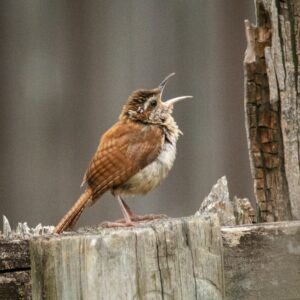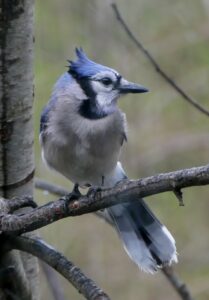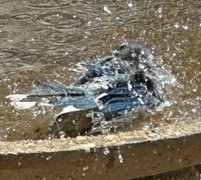After the lovely, peaceful dawn chorus fades away, who are those two LOUD mouths?

I was outside working in the garden, listening to the dawn chorus, and I finished in the garden as the chorus was ending. I came into the kitchen for a cup of hot coffee and turned on this website and the birdfeeder cam. My back was turned to the screen as I bent to pour my first cup of coffee. All of a sudden, I was jolted upright by what I can only say reminded me of a bugle call. The call was repeated over and over – drowning out every bird that was singing or calling. IT WAS SO LOUD!!!!!!!! So if you turn on either cam and all of a sudden are blasted by a bird you would swear is perched on your shoulder and singing right into your ear, that is the Carolina Wren.
Carolina Wrens sometimes come to feeders, they do live in yards and parks around feeders, but they most often do not eat anything at feeders unless it is suet on a very cold winter day. They are insect and spider eaters, not seed eaters. But they will come to feeders from time to time because they are one of the world’s nosiest birds. They live every day of their lives sticking those long, slender beaks into everyone’s business – always wanting to know what is going on – what all the fuss is. So, it is not unusual to see them at feeders, all over a squirrel’s nest, hopping all over a downed tree or rotting log, or completely hidden in complete tangles of plants – just poking around.

And who are the second loud mouths just after the dawn chorus – and also throughout the day right now? Blue Jays. The soft teedle-teedles of summer – which are mated birds keeping in touch – are over. Late summer and fall is when families come together to form loose flocks. And this is when these birds start screeching once again. This is not the screams of the young who are out of the nest but still dogging their parents’ every move demanding to be fed. These are adults – or first year birds who are now fending for themselves – and these are full-throated adult screeches and screams. When I come out the back door, they announce my presence. When they fly fast and hard into the feeder area, scattering every creature including squirrels, they announce their presence.

In my observation, Blue Jays are not just one of the noisiest birds, they are also one of the cleanest birds. You can watch them bathe in both bird baths on the birdfeeder cam and close-up in the birdbath cam. These birds will use any bird bath and generally like to bathe alone so will aggressively posture at any other bird – including another Blue Jay. if you see more than one Blue Jay peacefully using a birdbath, chances are good they were nest mates earlier this summer. These birds are thorough bathers and their baths tend to be long. it is not unusual for them to totally submerge themselves so they come out looking like drowned rats. After two or three Blue Jays take a bath, Cleon always has to add more water – they splash it everywhere!

